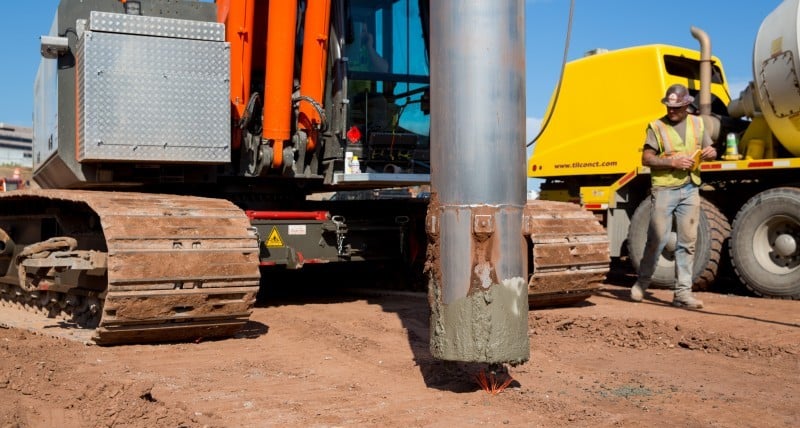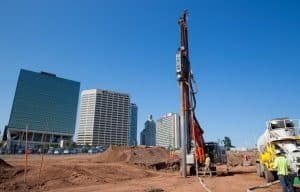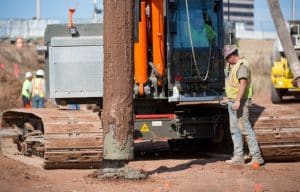Geopier Foundation Company® (Geopier) began pioneering the stiff-element ground improvement marketplace in 1989 by introducing their first patented ground improvement system, Rammed Aggregate Pier® (RAP) elements. Over 25 years later, RAPs are now well-known around the globe as a cost-effective solution for providing improved subgrade conditions for traditional shallow footing and slab-on-grade support on “poor-soil” sites. To date, over 7,000 Geopier ground improvement projects have been designed and installed worldwide as an alternative to traditional solutions such as over-excavation/replacement or deep pile foundations.
Since the introduction of RAPs, Geopier has developed several types of patented, engineered ground improvement systems, including rigid inclusion systems such as grouted Impact® RAPs, GeoConcrete® Columns (GCCs), and Armorpact® elements. As such, licensed Geopier designers and installers have multiple ground improvement systems “in their toolbox” to improve bearing capacity and control settlement in a wide variety of challenging subsurface conditions, including:
- Caving soils
- Loose sands
- Soft silts and clays
- Organic soils (peat, organic silt)
- Mixed soil layers
- Uncontrolled fill
- Contaminated soils
Geopier Ground Improvement
Helical Drilling (Helical) introduced Geopier ground improvement to the Northeast about 15 years ago and has since designed and installed Geopier systems on over 500 jobs. Many of Helical’s ground improvement jobs included the use of Geopier rigid inclusions, such as grouted Impact RAPs and GCCs.
“Helical is the global Geopier leader in the implementation of Grouted Impact Rammed Aggregate Pier (RAP) and GeoConcrete Column (GCC) rigid inclusion construction methods. We are proud to have Helical as a licensed Geopier element installer and their continued support to drive superior experience through the industry.” Kord Wissmann, Ph.D., P.E., D. GE., President and Chief Engineer of Geopier Foundation Company
[icon type=”caret-right” class=”right_carets”]Rigid InclusionsRigid inclusions are high-stiffness elements that work together with surrounding soils to transfer footing and slab loads down to a suitable bearing stratum. Because of their high stiffness, rigid inclusions attract relatively high stresses that must be transferred between the bottom of the footing and the tops of the elements. As such, an engineered structural fill pad (“footing pad”) is typically designed and installed on top of the rigid inclusions to help transfer footing and slab stresses to the elements and surrounding soil. [icon type=”caret-right” class=”right_carets”]Geopier Impact Rammed Aggregate Piers
Geopier Impact RAPs consist of stiff columns of rammed aggregate that are constructed with a patented displacement mandrel equipped with a beveled tamping foot. The mandrel and tamping foot apply direct vertical ramming energy to densely compact successive lifts of high quality crushed rock. The vertical ramming action also increases the lateral stress and improves the surrounding soils, resulting in high-stiffness engineered elements. The displacement mandrel generates little to no excess spoils and eliminates the need for casing or dewatering. This displacement construction method is particularly advantageous on sites with caving soils, contaminated soils, and/or shallow groundwater. Impact RAPs can also be grouted as rigid inclusions to provide enhanced stiffness through relatively soft soil layers (such as organics or soft clay). For these reasons, Impact RAPs are the most-used widely used Geopier ground improvement system in the Northeast.
Check out how Helical implemented grouted Geopier Impact RAP rigid inclusions for the Assembly Row Project in Somerville, MA.

Helical installing Geopier Impact RAPs
Geopier GCCs are rigid inclusion ground improvement elements that consist of stiff columns of unreinforced concrete that are constructed with a patented displacement mandrel. Similar to Impact RAPs, the displacement mandrel generates little to no excess spoils and is particularly advantageous on sites with caving soils, contaminated soils, and/or shallow groundwater. GCCs are an especially effective solution on sites with relatively thick, weak and compressible soils (such as organics or soft clay) combined with heavy structural loads.
Check out how Helical implemented Geopier GCC rigid inclusions for the 100 College Street Project in New Haven, CT.
- Helical installing Geopier GCCs
- Helical installing Geopier GCCs










